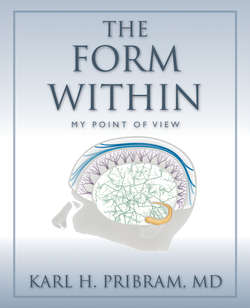Читать книгу The Form Within - Karl H Pribram - Страница 50
На сайте Литреса книга снята с продажи.
Critical Tests
ОглавлениеFergus Campbell provided an interesting sidelight on harmonics, the relationships among frequencies. The test was critical to viewing the perception of visual form as patterns of oscillation. When we hear a passage of music, we hear a range of tones and their harmonics. A fundamental frequency of a tone is produced when a length of a string is plucked. When fractions of the whole length of the string also vibrate, harmonics of the fundamental frequency are produced. When we hear a passage of music, we hear the fundamental tones with all of their harmonics. Surprisingly, we also hear the fundamental tones when only their harmonics are present. This is called experiencing the “missing fundamental.”
I was able to experience another exciting moment when in the 1970s I was visiting Cambridge, Fergus Campbell demonstrated that in vision, as in audition, we also experience the “missing fundamental.” Yes, the eye is like the ear.
The results of two other sets of experiments are critical to demonstrating the power of the frequency approach to analyzing visual patterns. Russell and Karen DeValois and their students performed these experiments at the University of California at Berkeley. In one set, they mapped an elongated receptive field of a cortical neuron by moving a single line in a particular orientation across the visual field of a monkey’s eye. (This form of mapping had been the basis of the earlier interpretation that cells showing such receptive fields were “line detectors.”) The DeValoises went on to widen the line they presented to the monkey until it was no longer a line but was now a rectangle: The amount of the cell’s response did not change! The cell that had been described as a line detector could not discriminate—could not resolve the difference—between a line and a rectangle.
In this same study, the experimenters next moved gratings with the same orientation as that of the single line across the visual field of the monkey. These gratings included a variety of bar widths and spacing (various spatial frequencies). Using these stimuli, they found that the receptive field of the cell was tuned to a limited bandwidth of spatial frequencies. Repeating the experiment, mapping different cortical cells, they found that different cells responded not only to different orientations of a stimulus, as had been found previously, but that they were tuned to different spatial frequencies: the ensemble of cortical cells had failed to discriminate between a line and a rectangle but had excellent resolving power in distinguishing between band widths of frequencies.
19. The missing fundamental: note that the patterns do not change: the bottom, as you view it, is the pattern formed with the fundamental missing
For the second set of experiments the DeValoises elicited a receptive field by moving a set of parallel lines (a grating) across the monkey’s receptive field. As noted earlier, one of the characteristics of such fields is their specificity to the orientation of the stimulus: a change in the orientation of the lines will engage other cells, but the original cell becomes unresponsive when the orientation of the grating is changed.
Following their identification of the orientation selectivity of the cell, the DeValoises changed their original stimulus to a plaid. The pattern of the original parallel lines was now crossed by perpendicular lines. According to the line detector view, the cell should still be “detecting” the original lines, since they were still present in their original orientation. But the cell no longer responded as it had done. To activate the cell, the plaid had to be rotated.
The experimenters predicted the amount of rotation necessary to activate the cell by scanning each plaid pattern, then performing a frequency transform on the scan using a computer program. Each cell was responding to the frequency transform of the plaid that activated it, not detecting the individual lines making up the plaid. Forty-four experiments were performed, and in 42 of them the predicted amount of, rotation came within two minutes of arc; in the other two experiments the results came within one degree of predicting the amount of rotation necessary to make the cell respond. Russell DeValois, a rather cautious and reserved person, stated in presenting these data at the meeting of the American Psychological Association that he had never before had such a clear experimental result. I was delighted.
20. Tuning functions for two representative striate cortex cells. Plotted are the sensitivity functions for bars of various widths (squares) and sinusoidal gratings of various spatial frequencies (circles). Note that both cells are much more narrowly tuned for grating frequency than for bar width. (From Albrecht et al., 1980, copyright 1980, AAAS. Reprinted by permission.)
